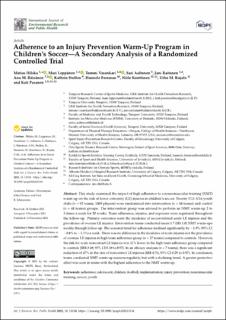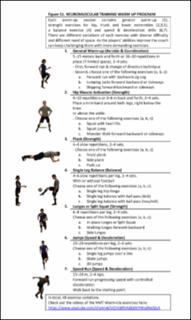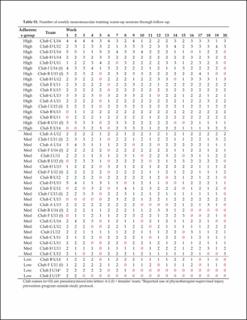| dc.contributor.author | Hilska, Matias | |
| dc.contributor.author | Leppänen, Mari | |
| dc.contributor.author | Vasankari, Tommi | |
| dc.contributor.author | Aaltonen, Sari | |
| dc.contributor.author | Raitanen, Jani | |
| dc.contributor.author | Räisänen, Anu M. | |
| dc.contributor.author | Steffen, Kathrin | |
| dc.contributor.author | Forsman, Hannele | |
| dc.contributor.author | Konttinen, Niilo | |
| dc.contributor.author | Kujala, Urho M. | |
| dc.contributor.author | Pasanen, Kati | |
| dc.date.accessioned | 2022-03-22T20:34:22Z | |
| dc.date.available | 2022-03-22T20:34:22Z | |
| dc.date.created | 2022-01-25T07:01:16Z | |
| dc.date.issued | 2021 | |
| dc.identifier.citation | International Journal of Environmental Research and Public Health. 2021, 18(24), Artikkel 13134. | en_US |
| dc.identifier.issn | 1661-7827 | |
| dc.identifier.uri | https://hdl.handle.net/11250/2986911 | |
| dc.description | This article is an open access article distributed under the terms and conditions of the Creative Commons Attribution (CC BY) license (https://creativecommons.org/licenses/by/4.0/). | en_US |
| dc.description.abstract | This study examined the impact of high adherence to a neuromuscular training (NMT) warm-up on the risk of lower extremity (LE) injuries in children’s soccer. Twenty U11–U14 youth clubs (n = 92 teams, 1409 players) were randomized into intervention (n = 44 teams) and control (n = 48 teams) groups. The intervention group was advised to perform an NMT warm-up 2 to 3 times a week for 20 weeks. Team adherence, injuries, and exposure were registered throughout the follow-up. Primary outcomes were the incidence of soccer-related acute LE injuries and the prevalence of overuse LE injuries. Intervention teams conducted mean 1.7 (SD 1.0) NMT warm-ups weekly through follow-up. The seasonal trend for adherence declined significantly by −1.9% (95% CI −0.8% to −3.1%) a week. There was no difference in the incidence of acute injuries nor the prevalence of overuse LE injuries in high team adherence group (n = 17 teams) compared to controls. However, the risk for acute noncontact LE injuries was 31% lower in the high team adherence group compared to controls (IRR 0.69, 95% CI 0.49 to 0.97). In an efficacy analysis (n = 7 teams), there was a significant reduction of 47% in the rate of noncontact LE injuries (IRR 0.53, 95% CI 0.29 to 0.97). In conclusion, teams conducted NMT warm-up sessions regularly, but with a declining trend. A greater protective effect was seen in teams with the highest adherence to the NMT warm-up. | en_US |
| dc.language.iso | eng | en_US |
| dc.subject | adherence | en_US |
| dc.subject | adolescent | en_US |
| dc.subject | children | en_US |
| dc.subject | football | en_US |
| dc.subject | implementation | en_US |
| dc.subject | injury prevention | en_US |
| dc.subject | neuromuscular training | en_US |
| dc.subject | soccer | en_US |
| dc.subject | youth | en_US |
| dc.title | Adherence to an injury prevention warm-up program in children’s soccer: A secondary analysis of a randomized controlled trial | en_US |
| dc.type | Peer reviewed | en_US |
| dc.type | Journal article | en_US |
| dc.description.version | publishedVersion | en_US |
| dc.rights.holder | © 2021 by the authors | en_US |
| dc.source.pagenumber | 12 | en_US |
| dc.source.volume | 18 | en_US |
| dc.source.journal | International Journal of Environmental Research and Public Health | en_US |
| dc.source.issue | 24 | en_US |
| dc.identifier.doi | 10.3390/ijerph182413134 | |
| dc.identifier.cristin | 1989052 | |
| dc.description.localcode | Institutt for idrettsmedisinske fag / Department of Sports Medicine | en_US |
| dc.source.articlenumber | 13134 | en_US |
| cristin.ispublished | true | |
| cristin.fulltext | original | |
| cristin.qualitycode | 1 | |


